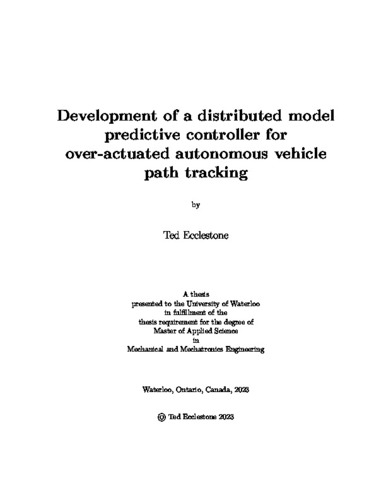UWSpace will be migrating to a new version of its software from July 29th to August 1st. UWSpace will be offline for all UW community members during this time.
Development of a Distributed Model Predictive Controller for Over-Actuated Autonomous Vehicle Path Tracking
| dc.contributor.author | Ecclestone, Ted | |
| dc.date.accessioned | 2023-04-19 13:00:23 (GMT) | |
| dc.date.available | 2023-04-19 13:00:23 (GMT) | |
| dc.date.issued | 2023-04-19 | |
| dc.date.submitted | 2023-04-15 | |
| dc.identifier.uri | http://hdl.handle.net/10012/19287 | |
| dc.description.abstract | Widespread interest in the advancement of autonomous vehicle technology is motivated by multiple outstanding issues associated with vehicular travel despite the decades-long ubiquity of this mode of transportation. It is well known that the leading cause of accidents on the road is human error. Furthermore, vehicle hardware faults and harsh environmental circumstances are also common collision factors due to the challenges that they introduce to the driving task. Autonomous vehicles have the potential to greatly exceed the perception, decision making, and control capabilities of human drivers in some applications, and the large-scale adoption of this technology will thereby mitigate the primary driving-related safety concerns. Numerous additional benefits will be realized as a result; for instance, complex planning algorithms will help to reduce traffic congestion, and transportation- and insurance-related costs will be minimized due to the lower collision rates. Though it may be many years before the technology sees extensive use for passenger transportation applications due to the complexity of standard driving environments, autonomous vehicles will likely find use over the short-term in other specialized domains. For example, these vehicles can be used to transport payloads over short distances in a wide variety of applications, including agriculture, mining, and shipping, where the operating environment is less complex. In these scenarios, autonomous vehicle technology will help to lessen the effects of labour shortages while enabling longer operating hours at a lower cost. A key component of the autonomous stack is the motion controller, which serves to regulate the longitudinal and lateral motion of the vehicle according to a defined set of objectives by precisely manipulating the available actuators. Model predictive control (MPC) is a powerful control strategy commonly used for this purpose; the algorithm can coordinate a large set of control inputs such that the system meets all defined objectives while satisfying any constraints on the states and inputs. Many prior works investigate the use of MPC, and its variants, for vehicle path tracking and stability control applications. One such variant is distributed MPC; with this approach, the controlled plant is modelled as a set of interacting subsystems, each subsystem using its own MPC controller to select a set of optimal control actions in combination with all others. An extension of distributed MPC, agent-based MPC (AMPC), enhances the control capabilities by allowing the controller to additionally consider both the effect of subsystems that are not controllable by the optimal controller and the effects of hardware faults on the system dynamics. While previous works have investigated the application of AMPC to vehicle stability control tasks, in this thesis, AMPC is utilized to perform path tracking. The vehicle hardware platform considered in this work, WATonoTruck, is modular and over-actuated in design, making it a suitable test platform for AMPC. Built using the corner module platform, the wheels at each corner can be independently driven and steered. A vehicle dynamics reference model to represent the behaviour of WATonoTruck is constructed; this model utilizes a nonlinear tire force model to accurately characterize the tire-road interaction, and incorporates Ackermann geometry to prevent unecessary wheel slip and reduce the control task complexity that results from the over-actuated nature of the system. This model serves as the prediction model for the designed AMPC controller. The controller also considers numerous constraints on the vehicle states, inputs, and input rates to ensure stability, and can incorporate an external longitudinal controller and account for actuator faults. The controller is validated over several simulated and experimental tests that demonstrate its ability to provide effective path tracking and velocity control performance in a varied set of scenarios, including those where actuator failures occur or the driving environment is harsh. | en |
| dc.language.iso | en | en |
| dc.publisher | University of Waterloo | en |
| dc.subject | autonomous driving | en |
| dc.subject | model predictive control | en |
| dc.subject | agent-based model predictive control | en |
| dc.subject | vehicle control | en |
| dc.subject | vehicle dynamics | en |
| dc.title | Development of a Distributed Model Predictive Controller for Over-Actuated Autonomous Vehicle Path Tracking | en |
| dc.type | Master Thesis | en |
| dc.pending | false | |
| uws-etd.degree.department | Mechanical and Mechatronics Engineering | en |
| uws-etd.degree.discipline | Mechanical Engineering | en |
| uws-etd.degree.grantor | University of Waterloo | en |
| uws-etd.degree | Master of Applied Science | en |
| uws-etd.embargo.terms | 0 | en |
| uws.contributor.advisor | Khajepour, Amir | |
| uws.contributor.affiliation1 | Faculty of Engineering | en |
| uws.published.city | Waterloo | en |
| uws.published.country | Canada | en |
| uws.published.province | Ontario | en |
| uws.typeOfResource | Text | en |
| uws.peerReviewStatus | Unreviewed | en |
| uws.scholarLevel | Graduate | en |

